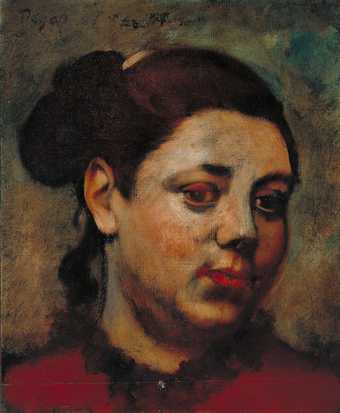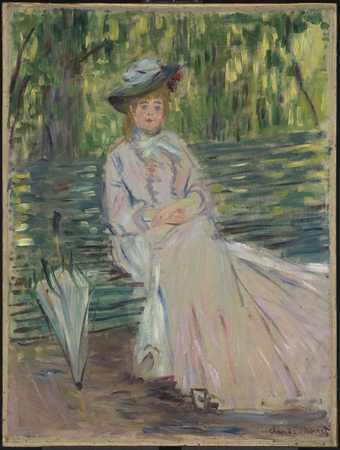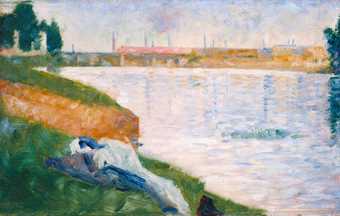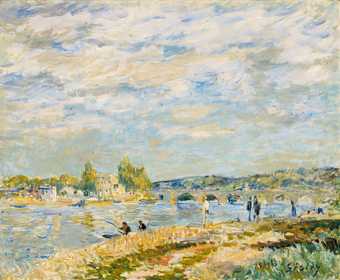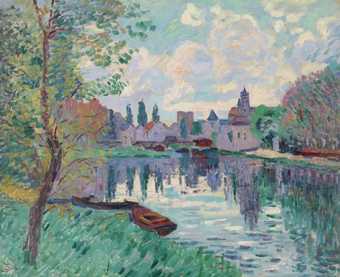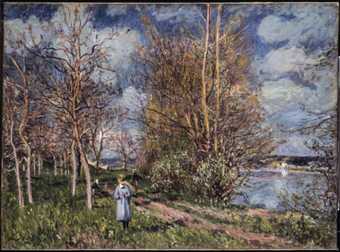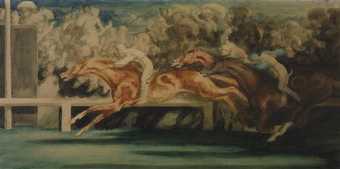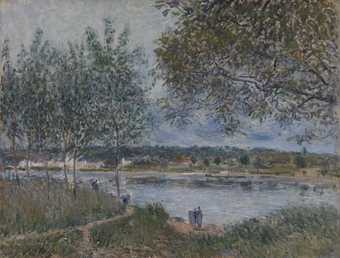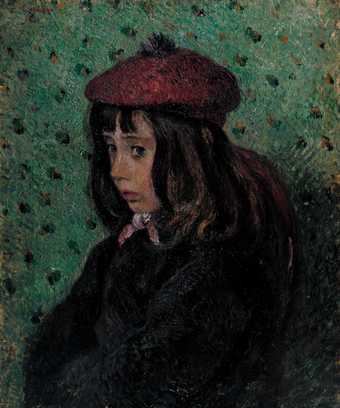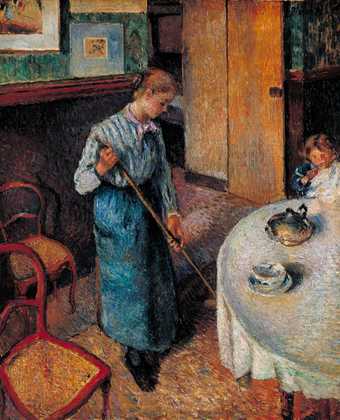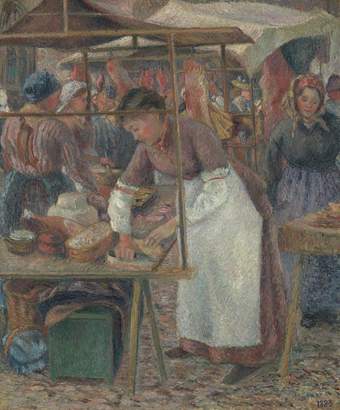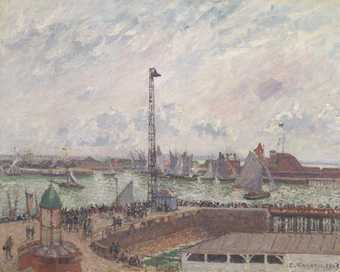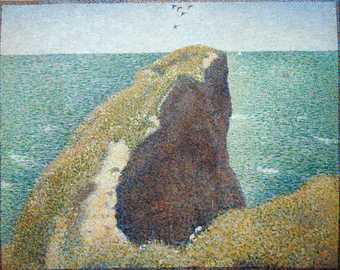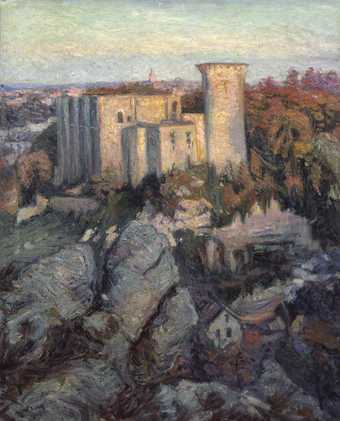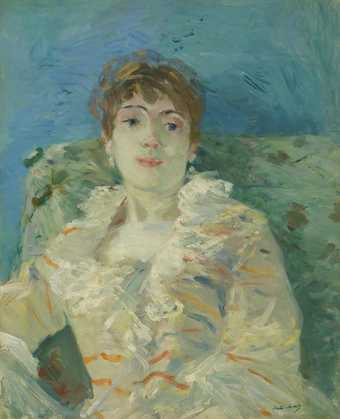
On loan
Auckland Art Gallery (Auckland, New Zealand): Light
- Artist
- Claude Monet 1840–1926
- Original title
- Les Peupliers au bord de l'Epte
- Medium
- Oil paint on canvas
- Dimensions
- Support: 924 × 737 mm
frame: 1106 × 954 × 115 mm - Collection
- Tate
- Acquisition
- Presented by the Art Fund 1926
- Reference
- N04183
Display caption
In the summer of 1891 Monet learned that a row of poplars on the river Epte, near to his home at Giverny, were to be felled. Monet paid for them to be left standing long enough for him to paint them. In all he executed twenty-three paintings of this scene, and exhibited a group of them together in 1892. Eleven of these show this same view at different times of day and in different weather conditions. A particularly marked feature of this work is its combination of a strong surface pattern, emphasised by vigorous brushwork, and the suggestion of pictorial depth conveyed by the continuous zig-zag of trees leading back into the distance.
Gallery label, August 2004
Does this text contain inaccurate information or language that you feel we should improve or change? We would like to hear from you.
Catalogue entry
Claude Monet 1840-1926
N04183 Les Peupliers au Bord de l'Epte (Poplars on the Epte) 1891
Inscribed 'Claude Monet 90' b.r.
Oil on canvas, 36 3/8 x 29 (92 x 74)
Presented by the National Art-Collections Fund 1926
Prov: [? Russian private collector (purchased from the artist)]; with Paul Rosenberg, Paris; NACF 1926
Exh: [? Exposition d'Oeuvres Récentes de M. Claude Monet (Série des Peupliers), Durand-Ruel, Paris, February-March 1892 (8)]; Quelques Oeuvres par Claude Monet, Paul Rosenberg, Paris, October-November 1924 (15); Opening Exhibition of the Modern Foreign Gallery, Tate Gallery, June-October 1926 (works not numbered); Claude Monet, RSA, Edinburgh, August-September 1957 (90, repr.); Tate Gallery, September-November 1957 (90, repr.); Claude Monet: Seasons and Moments, Museum of Modern Art, New York, March-May 1960 (54); Los Angeles County Museum, June-August 1960 (54)
Lit: Théodore Duret, Manet and the French Impressionists (London 1910), p.144; Marc Elder, A Giverny, chez Claude Monet (Paris 1924), p.12; Gustave Geffroy, Claude Monet: sa Vie, son Oeuvre (Paris 1924), Vol.2, pp.59-62; Lilla Cabot Perry, 'Reminiscences of Claude Monet from 1889 to 1909' in American Magazine of Art, XVIII, 1927, p.121; Lionello Venturi, Les Archives de l'Impressionnisme (Paris-New York 1939), Vol.1, pp.340-2; Oscar Reuterswärd, Monet (Stockholm 1948), pp.195-200, repr. p.196; René Gimpel, Journal d'un Collectionneur Marchand de Tableaux (Paris 1963), pp.318-19; Daniel Wildenstein, Claude Monet: Biographie et Catalogue raisonné (Lausanne-Paris 1979), Vol.3, No.1300, p.148, repr. p.149 as 'Les Peupliers au Bord de l'Epte' 1891
Repr: Burlington Magazine, XLIX, 1926, p.16; The Tate Gallery (London 1969), p.100
One of a series of twenty-three paintings of the poplars on the left bank of the Epte near Limetz about two miles from Giverny, executed during the warmer months of 1891. As the township of Limetz sold the poplars on 2 August while Monet was still working on this series, he arranged with the lumber dealer who wanted the wood to make a contribution to the purchase price on condition that the trees were left standing for a few more months. Finishing touches were added to several of the paintings in February 1892, just before the opening of his exhibition of 15 works from this series at the Galerie Durand-Ruel towards the end of that month.
Most of the paintings were made from a position from which he could take advantage of the S curve formed by the poplars as they lined the winding bank of the river (a long and sinuous curve which is said by Duret to have reminded him of the line of cedars in Hiroshige's 'Fifty-three stations of the Tokaido'), and eleven show more or less this view, with six to eight trees in the foreground and a broad expanse of foliage above. The series was painted from a flat-bottomed boat fitted with slots to hold a number of canvases. Some of the effects only lasted a few minutes, when he took out the next canvas and worked on that. The paintings depict different effects of light and different times of the day.
All the other pictures of this viewpoint are either dated 1891 or are undated, and it seems that the date 1890 on this one was a mistake and that it must have been painted at the same time as the others and signed and dated some time later. (The inscription appears to be in the handwriting of Monet's old age). It has been left in a sketchy condition, whereas the others are more finished and mostly show signs of extensive reworking. Mme Blanche Hoschedé-Monet told Oscar Reuterswärd that it was Monet's favourite version and occupied a place of honour in his studio for several years, until he was persuaded to sell it to a Russian collector. Little is known about its early provenance, but a torn label on the back of the packers Day and Meyer, Murray and Young, Corp., of New York shows that it was in New York some time prior to its acquisition by the Tate.
Published in:
Ronald Alley, Catalogue of the Tate Gallery's Collection of Modern Art other than Works by British Artists, Tate Gallery and Sotheby Parke-Bernet, London 1981, pp.537-9, reproduced p.537
Explore
- emotions, concepts and ideas(16,416)
-
- formal qualities(12,454)
- cities, towns, villages (non-UK)(13,323)
-
- Limetz(1)
- France(3,508)
- River Epte(1)
You might like
-
Edgar Degas Head of a Woman
c.1874 -
Claude Monet Woman Seated on a Bench
c.1874 -
Georges Seurat Clothes on the Grass
1883 -
Alfred Sisley The Bridge at Sèvres
1877 -
Armand Guillaumin Moret-sur-Loing
1902 -
Alfred Sisley The Small Meadows in Spring
1880 -
Louis Anquetin The Finish of the Horse Race
c.1898–9 -
Alfred Sisley The Path to the Old Ferry at By
1880 -
Camille Pissarro Portrait of Felix Pissarro
1881 -
Camille Pissarro The Little Country Maid
1882 -
Camille Pissarro The Pork Butcher
1883 -
Camille Pissarro The Pilots’ Jetty, Le Havre, Morning, Cloudy and Misty Weather
1903 -
Georges Seurat Le Bec du Hoc, Grandcamp
1885 -
Othon Friesz The Castle of Falaise (Evening)
1904 -
Berthe Morisot Girl on a Divan
c.1885

